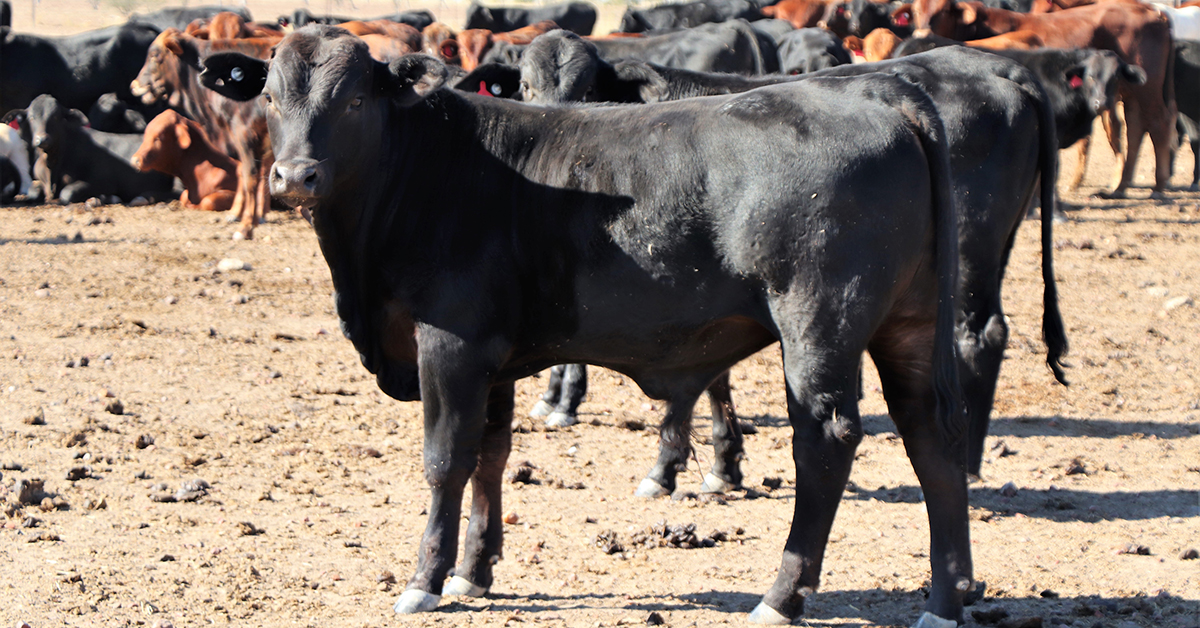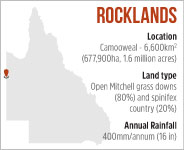Angus at Large Scale


Straddling the Queensland and Northern Territory border and encompassing the township of Camooweal, “Rocklands” runs at a scale unique to the Northern Beef Industry.
 On a backdrop of 6,600km2 and a mixture of open downs and spinifex country (roughly 80% and 20%, respectively), Paraway Pastoral Company run 44,000 head in a breeding enterprise producing an Angus Santa cross article.
On a backdrop of 6,600km2 and a mixture of open downs and spinifex country (roughly 80% and 20%, respectively), Paraway Pastoral Company run 44,000 head in a breeding enterprise producing an Angus Santa cross article.
While “Rocklands” is a part of the larger Paraway portfolio, one of eight businesses in Northern Australia, operations on “Rocklands” and indeed the rest of the portfolio are regarded as stand alone.
Steer progeny, while retained in Paraway ownership are sold at market prices into backgrounding and fattening enterprises in Paraway’s Queensland’s channel country
and Maranoa district holdings, such as “Tanbar” (Windorah), “Davenport Downs” (Winton) and “Moira Runda” (Condamine).
Matt Barrett, with his wife Tina, manage “Rocklands” and the 26 staff it employs. Coming with considerable experience in company run pastoral operations both on the Barkly Tablelands and the Channel Country, Matt describes running a breeding operation of this scale on downs country as a challenge.
“Compared to the channel country, the Barkly is a little more consistent and more of a challenge because you are breeding as opposed to backgrounding and fattening. We brand 15,000 calves a year here, it is just a bigger challenge,” he says.
Breeding in Big Numbers
The breeding enterprise at “Rocklands” currently consists of 24,000 breeders, 7,500 heifers joined for the first time earlier in the year, 6,500 yearling heifers and a bull herd of 1,000 bulls, in addition to the sale of 7,500 weaner steers and other cull animals but fluctuate depending onseasonal conditions.
The majority of heifers are initially joined at 2 years of age; however, some are joined as yearlings depending on weight and maturity.
“We do that for two reasons, one, they are big and mature enough and secondly, we join them to a bull of our choice rather than an unsuitable herd bull,” explains Matt.
For their first joining, heifers are joined with newly purchased bulls in December, with the view to calve down in October, November and December the following year.
From then on, bulls are run with the breeders year-round.
“As the breeders get older, they do drift into 13-15 month calving intervals. Our bulls stay out year-round but we preg-test and draft them into groups based foetal age each year,” he says.
“Our pregnancy rates are seasonal dependent, for the dry cows that have weaned a calf in September and are being rejoined in Decemebr, 98% are back in calf. For mature cow, the 12-month rebreed rate is roughly 40% and those that are wet, still with a weaner at foot, 80% are back in calf,” says Matt.
Although calving interval and rebreeding rates are of interest, Matt identifies calf loss as the biggest issue on “Rocklands”.
“Calf loss and rebreeding rate are our biggest challenges. “Rocklands” is in line with industry average for the North for calf loss, but I still feel that is too high. It is improving, currently we are probably 5-8% better than last year, however it’s too high. I think that there is a dozen or so different things that result in calf loss, heat, nutrition, crowding at waters, just the scale of the enterprise, dogs, it all adds up. We have trials going on at the moment, trying to identify nutritional factors in partnership with UQ through the Calf Alive Project,” he adds.
Having raised a calf is a key requirement for breeding females at “Rocklands” – with any returning without a calf culled. Cows are also culled for age at ten years old.
When it comes to replacement heifer selection, as many as possible are joined.
“Our cull rate on the heifers is around 5%. We join as many as we can, the 5% that are culled are purely on type, weight for age and temperament. Also, when they get joined, anything that fails to join and preg-test in calf is a cull as well, which is around 10%,” says Matt.
Getting the Best out of Black Bulls
The bull herd at “Rocklands” is 50% Angus and 50% Santa, with bulls backcrossed over the female herd (Santa bulls over Angus cross cows, and Angus bulls over Santa cross cows) to ideally produce an F1 progeny that has higher marketability while retaining some adaptation.
“The fertility of Angus is a highlight, their marketability is right up there, their growth and weight gain, they are the traits we really like in the Angus. The cross with Santa is to bring the tropical adaptability, heat tolerance and walking ability into the herd,” says Matt.
When it comes to bull selection, selection criteria are regarded very stringently.
“We select bulls on conformation and we select very heavily on EBVs, with the biggest focus on Days to Calving EBVs. Fertility, low birthweight, moderate framed animals with high 200 and 400 day weight EBVs are highly sought after and we have recently started selecting for IMF,” says Matt.
When asked about the steps they take to manage the Angus bulls acclimatisation and their survivability in the “Rocklands” environment, Matt indicated that they take some steps to get the most from their investment.
“Bull survival is fine. We buy them and we get them up here early in the year, for example in June we took delivery of 240 of the 300 new bulls we need for this year. Once they are here, we feed them in a paddock by themselves and give them six months to acclimatise before joining for the first time in December. It gives them the chance to mature, grow a bit as well and harden up a bit to the climate before they go out to work,” says Matt.
“Come June-July when we are pregtesting if the bulls are good solid, sound bulls they stay out. If they need a bit of help, we bring them back in and put them with their cohorts in a paddock and supplement their feed until December and then they go back out to work. We do that just to help their survivability and to give them a better chance to get the cows in calf come December. The ones that in poorer condition are likely to be the ones that have been working harder anyway so we look after them a bit,” he says.
“Acclimatisation of six months seems to be working but you have got to buy the right bulls. When we are selecting our bulls from breeders we don’t buy the hairy or woolly rough looking blokes, we try to buy the clean coated, strong footed, good conformation types,” he adds.
In Matt’s experience the slicker coated the animal, the more heat tolerant the animal appears to be.
A sample (approximately 10%) of all bulls are BullCHECK tested annually, a component of which is crush side semen test and bulls are culled for age at around 8 years old.
Recently Paraway has embarked on a custom breeding program, producing F1 Angus Santa bulls with the view to address the variability of the current cross breeding program and create some more consistency in progeny line.
“We have had a number of years now where we are up to second and third crosses and they have calves that range from one end of the spectrum to the other. When you get your first cross it tends to be a very tight line, second and third cross they tend to disperse a bit. If we can try and tighten that back up by using these F1 bulls it will be a good result,” says Matt.
Country Utilisation and the Infrastructure to Back it
Infrastructure at “Rocklands” has been an extensive development with water the primary focus. In a bid to utilise as much of “Rocklands” as possible, watering points have been strategically positioned within 3km grazing radius of each other (6km between waters), with approximately 80% of the place within 3km of water.
Grazing management has also been a focus of development, with paddocks being fenced in respect to land type and to sizes that equate to relatively similar carrying capacities of approximately 800 head per paddock across all land types. Paddocks on “Rocklands” range from 7,000 ha to 40,000 ha.
Each year, every paddock’s carrying capacity is assessed and is matched with the appropriate stocking rate. It is through this regular assessment that a spelling regime is implemented, based on country condition which in turn aids the destocking process in the event of drought.
Matt describes the benefit of this style of grazing management particularly in the event of a failed wet season.
“We stock our country to the green date of 21st January, it is a trigger point to start offloading cattle. By having stocked our country to the land type and carrying capacity, we aren’t in dire straits immediately,” he says.
“From there, there are a number of levers we can pull such as selling stock we had set up to rejoin, blanket early weaning certain mobs and selling the percentage of those cows that failed to raise a calf,” he adds.
Sage Advice
Due to low disease challenge the major limitations in Angus use on “Rocklands” are predominantly adaptation related. To combat this, Matt offers this advice for people wanting to bring Angus bulls into northern Australia.
“Select the bulls for the country, make sure they have that natural heat tolerance, that they are clean coated and strong footed. In the handling of Angus cattle, don’t expect them to walk the same distances you can walk a Brahman cow and calf, they are slower and you just have to adjust accordingly, but when you get them there you are selling them at $200 extra a calf so just walk slower, it is as simple as that,” he says.
“We have got our paddocks split up, they are relatively small for the area we are in and that aids in minimising the distance that they have to travel,” he adds.
Oddly enough, Matt says that one of the biggest issues they have is the high fertility resulting in heifer calves having early and out of season calves.
“It is a challenge for those heifers to raise that calf and then get back in calf again,” he states.
So, is the use of Angus paying off at “Rocklands”? Weaning weights have been increased, despite the seasons being, as Matt describes them, not fantastic.
“Season has got an affect, but the seasons here haven’t been fantastic and the weaning weights have increased. It has made a difference, our weaning weight at the start of 2022 was 260kg. That will reduce to approximately 220kg as the year progresses and we wean other mobs but it is a pretty good start to the year,” says Matt.
Jen Peart, Northern Development Officer
Angus Australia acknowledges the funds provided by the Australian Government through the Meat & Livestock Australia Donor Company (MDC).
This resource was created as a result of a collaboration between Angus Australia and Meat & Livestock Australia Donor Company (MDC) (Project P.PSH.1063).